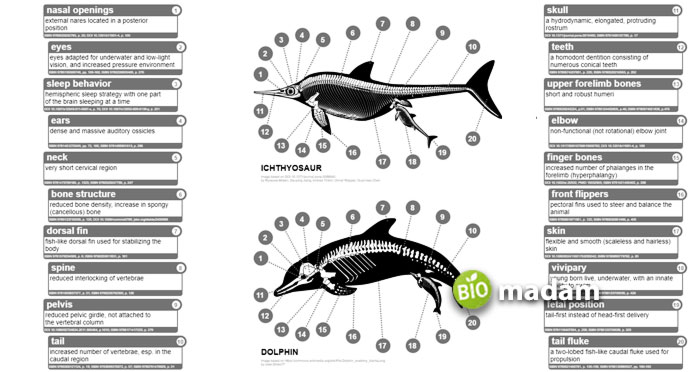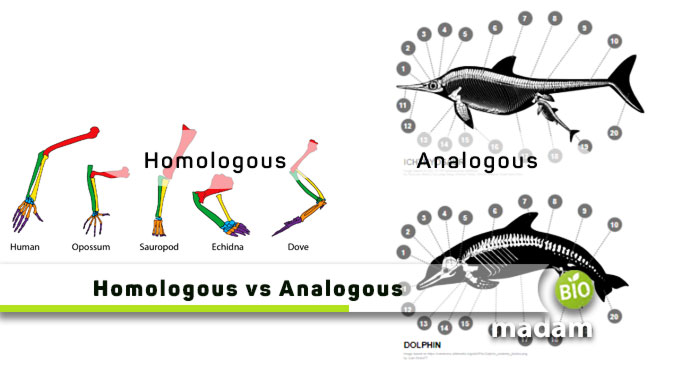Recently updated on March 31st, 2023 at 06:58 am
Homologous and analogous are often confused by biology students when learning them initially. However, the difference between homologous and analogous is pretty simple. Homologous structures look similar but perform different functions. Alternatively, analogous structures have dissimilar anatomy yet similar physiology. Homologous structures are common in organisms with shared ancestors. Whereas organisms with analogous structures may not be closely related. Let’s tell you more about them both to help you understand better.
Comparison Table
| Characteristics | Homologous | Analogous |
| Anatomy | Similar | Different |
| Function | Different | Similar |
| Ancestry | Same | Different |
| Evolution | Divergent | Convergent |
| Pattern of Development | Similar | Different |
| Influence of Environment | Different | Similar |
| Evolutionary Relationship | Yes | No |
| Animal Example | Human arm, cat limb, batwing | Bind & insect wing |
| Plant Example | Venus fly trap & pitcher plant | African euphorbia & cactus |
What are Homologous Structures?
The word Homologous comes from the Greek words, Homos and Logos. Homo means same, and logos means relation. Homologous literally translates to “having the same relation.”
Homologous structures are similar in morphology in organisms that have common ancestors. These structures look quite similar, while they might have different functions. However, it does not mean that homologous structures look exactly the same. Their apparent structure might change according to need and usage. Yet, the anatomy is somehow similar. Closely related species from a genus often have homologous traits as well.
There are three fundamental types of homology; morphological homology, ontogenetic homology, and molecular homology. The most commonly studied homology is the homology of the anatomy of morphological homology. Ontogenetic and molecular homology refers to embryological and DNA/ RNA structure similarities, respectively.
Homologous structures are quite common in divergent species. Divergent species refer to closely related species that reduce or improve their body parts’ functionality during micro and macroevolution. When the organisms develop through divergent evolution, the functions also differ.
This could be due to several reasons like surviving in a different environment, changes in the present habitat, etc. One such example is the tail. Humans have a tailbone to support the structure but lack a tail, unlike cats, etc. The tail is a vestigial organ in humans.
Example of Homologous
A common example of homologous structures is the arms and legs. Animals and humans do not use their limbs the same way. Yet, they have similar bones in their legs, while the functions are not the same. It shows how the utilization of these organs has modified their appearance.

What are Analogous Structures?
The word Analogous comes from Analogy which represents the comparison of two different things based on their similarities. Analogous structures are those having a different structure but a similar function. It also means that these structures or parts evolved uniquely in different organisms for the same purpose. Contrary to homologous structures, the analogous structures may not have the same ancestral origin.
A common reason for similar functions and different structures could be natural selection. Many species compete to live in an environment, and even with varying structures, they sometimes tend to adopt similar functions. As opposed to homologous structures, analogous structures develop due to convergent evolution. Body parts may emerge, rearrange or disappear during convergent evolution depending on the individual’s need.
Example of Analogous
An example of an analogous structure is the internal body structure of fish and squid. Though they do not look similar, their bodies enable them to swim conveniently. Such a kind of evolution is usually referred to as convergent evolution. Another example is the human eye and the octopus eye. While they are not closely related, the eyes of humans and octopuses are quite similar in function.

Differences Between Homologous and Analogous Structures
Definition
Homologous Structures
Homologous structures have similar anatomy but perform different functions.
Analogous Structures
Analogous structures perform similar functions but do not share the same organ structure.
Anatomy
Anatomy is the main difference between homologous and analogous structures.
Homologous Structures
Homologous structures have similar anatomy even though they may not look so apparently.
Analogous Structures
On the other hand, analogous structures have dissimilar anatomy despite similar appearance and function.
Function
Homologous Structures
Homologous structures have different functions besides similar structures.
Analogous Structures
Yet, analogous structures may not have the same structure but have similar functions.
Ancestry
Homologous Structures
Homologous structures are typically obtained from a common ancestor.
Analogous Structures
On the contrary, analogous structures do not come from a common ancestor.
Evolution
Homologous Structures
Homologous structures result from divergent evolution.
Analogous Structures
In comparison, analogous structures develop as a result of convergent evolution.
Development
Homologous Structures
Homologous structures have quite a similar development pattern.
Analogous Structures
The developmental pattern of analogous structures is quite different from one another.
Environmental Influence
Homologous Structures
Homologous structures usually arise from surviving in a different environment.
Analogous Structures
Conversely, analogous structures develop from the fight to survive in the same environment.
Evolutionary Relationship
Homologous Structures
Homologous structures arise in related species and can help study the relationship between different species.
Analogous Structures
At the same time, analogous structures are not in related species. Thus, they do not provide much information about evolutionary relationships.
Animal Example
Homologous Structures
A common example of homologous structure is the similarity between the human arm, cat leg, and bat wing. They do not look the same or perform one function but have similar anatomy.
Analogous Structures
Bird and insect wings explain homology in animals well. The size and structure may vary, yet both facilitate flying.
Plant Examples
Homologous Structures
Modified leaves of the pitcher plant and Venus flytrap are prominent examples of homologous structures in plants.
Analogous Structures
Examples of analogous structures in plants include cacti and African euphorbia.
The Bottom Line
Homologous and analogous structures play a major role in identifying evolutionary relationships between organisms. The fundamental difference between homologous and analogous structures is their anatomy. Homologous structures are similar in structure but different in function. On the other hand, analogous structures have similar functions despite varying structures. Homology typically arises from changing environments, whereas analogy results from survival in the same environment.
FAQs
What is the origin of homologous structure?
Homologous structures genetically come from the structure of the last common ancestor. They are of great importance when understanding the evolutionary relationship between organisms.
What are homologous traits?
Homologous traits are the shared similarities between different organisms with a similar ancestor. These traits can be inherited from the parents to the children.
What term describes the wings of insects, bats, and birds?
The wings of insects, bats, and birds are analogous structures. While they have different structures, they essentially perform the same function.

Jeannie has achieved her Master’s degree in science and technology and is further pursuing a Ph.D. She desires to provide you the validated knowledge about science, technology, and the environment through writing articles.

